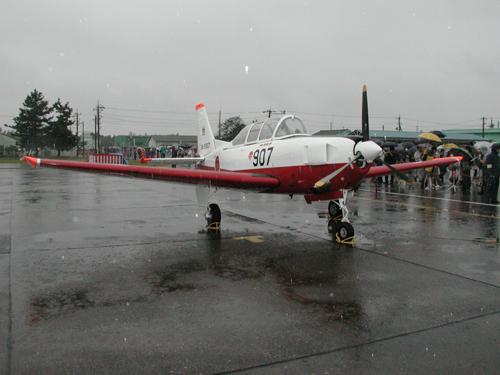- Fuji T-7
infobox Aircraft
name = T-7
type = Trainer
manufacturer =Fuji Heavy Industries
national origin =Japan
caption = A T-7 on display at Hamamatu AB, Japan
designer =
first flight =
introduced =
introduction=
retired =
status =
primary user =Japan Air Self-Defense Force
more users =
produced =
number built =
unit cost =
developed from =Fuji T-3
variants with their own articles =The Fuji T-7 (previously T-3 Kai) is a
Japan ese primary trainer aircraft built byFuji Heavy Industries for theJapan Air Self-Defense Force . A development of Fuji's earlier T-3 trainer, it is a single enginedmonoplane powered by aturboprop engine.Development and design
The Fuji T-7 was developed to meet a requirement of Japan's Air Self Defence Force for a primary or basic trainer to replace the Fuji T-3. The resultant aircraft was a modified version of the T-3, (itself descended via the
Fuji KM-2 from the Beech T-34) and shared the single engined low-winged monoplane layout of the T-3, but replaced theLycoming piston engine with an Allison 250turboprop engine.The T-7 was selected in preference to the
Pilatus PC-7 in 1998, Mollet 1998, p.31.] but this decision was cancelled and the competion re-started after a corruption scandal arose, with several managers from Fuji being arrested for bribing an official in Japan's ruling Liberal Democratic Party. Jeziorski 2000, p.20]Operational history
Fuji re-entered the T-7 (then known as the T-3 Kai) and again won the re-started competion in September 2000, the first production aircraft being handed over in September 2002.
Operators
;JPN
*Japan Air Self-Defense Force pecifications (T-7)
aircraft specifications
plane or copter?=
jet or prop?=ref="Military Aircraft Directory", Flight International Ripley 25-31 May 2004, p.57.]
crew=2
capacity=
length main= 8.59 m
length alt= 28 ft 2 in
span main= 10.04 m
span alt= 32 ft 11 in
height main= 2.96 m
height alt= 9 ft 9 in
area main= 16.50 m²
area alt= 177.60 ft²
airfoil=
empty weight main=
empty weight alt=
loaded weight main=
loaded weight alt=
useful load main=
useful load alt=
max takeoff weight main= 1,585 kg
max takeoff weight alt= 3,487 lb
more general=engine (prop)=Rolls-Royce (Allison) 250-B17F
type of prop=turboprop
number of props=1
power main= 336 kW
power alt= 450 shp
power original=max speed main= 376 km/h
max speed alt= 203 knots, 234 mph
cruise speed main= 296 km/h
cruise speed alt= 160 knots, 184 mph
stall speed main= 103 km/h
stall speed alt= 56 knots, 64 mph
never exceed speed main=
never exceed speed alt=
range main=
range alt=
ceiling main= 7,620 m
ceiling alt= 25,000 ft
climb rate main=
climb rate alt=
loading main=
loading alt=
thrust/weight=
power/mass main=
power/mass alt=
more performance=armament=
avionics=
ee also
aircontent
related=
*Fuji T-3
*Fuji KM-2
*Fuji T-5
*T-34 Mentor similar aircraft=
* Aérospatiale/Socata TB-30 Epsilon
*Socata TB-31 Omega
*Pilatus PC-7
*Pilatus PC-9
*T-6 Texan II
*KAI KT-1
*PZL-130 Orlik
*Embraer EMB 312 Tucano
*T-34 Mentor
*T-35 Pillán
*Utva Lasta
lists=see also=
References
Notes
Bibliography
* Mollet, Andrew. " [http://www.flightglobal.com/pdfarchive/view/1998/1998%20-%202467.html Japan's T-7 decision saves Fuji's day] ". "
Flight International ", 9 - 15 September 1998, p. 31.
* Jeziorski, Andrzej. " [http://www.flightglobal.com/pdfarchive/view/2000/2000%20-%200892.html T-3 replacement battle re-opens] ". "Flight International ", 28 March - 3 April 2000, p.20.
* Ripley, Tim. "Military Aircraft Directory" "Flight International ", 25-31 May 2004, p. 38-73.External links
* [http://www.globalsecurity.org/military/world/japan/t-3.htm Globalsecurity.com]
* [http://www.airliners.net/search/photo.search?countrysearch=Japan&aircraft_genericsearch=Fuji+T-7&distinct_entry=true Photo]
Wikimedia Foundation. 2010.

